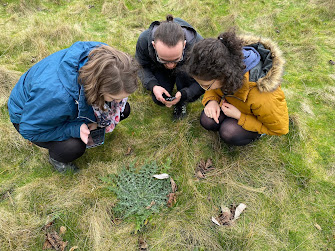January 2021 - earwig affection
 |
| Juvenile earwig 31st Jan. 2021 (Forficula auricularia) |
The Long-Lost Tale of the Mother Earwig
The sun dips below the horizon and makes way for a full
moon. The sky above is replaced with navy blues and twinkling stars, and a soft
dew settles in glistening droplets across the stems of a grassy opening. The
coolness of the air settles in for the night and everything is still and quiet.
In a small burrow, at the bottom of the garden, something is stirring. A male
earwig, stocky and dark brown runs from a small hole, quickly followed by a
female. Their long legs moving furiously as she chases him away, raising her
mandibles viciously at him. His work here is done. She needs to be alone. As
soon as he is out of sight, she raises her large head, her black compound eyes
glisten in the moonlight. She is readying herself for something. Her antenna
brush along the grass as she moves through the undergrowth. A fallen apple
provides a relieving meal and she munches at the bruised edges of a crevice,
perhaps previously created by a hungry slug. A rustling nearby echoes through
the stillness, sending vibrations under her. She stops. A small field mouse
runs by, seemingly uninterested by her and now the coast is clear. She moves
down from the fallen fruit, her elongated body moving to the curvatures of the
soil, her cerci are straight, moving gently above the ground. She is close to
the burrow now, it is time.
Beneath a large leaning apple tree is a long piece of
slate that conceals the entrance to her chamber. It is small and modest, two
inches under the ground. The earth around her is moist, providing well needed
shelter and warmth. She is safe here. She spends the next few moments moving
around, ensuring everything is cleared and ready. A ripple rolls through her
swollen abdomen, her wing cases tight against her body. The time is here, Egg
laying has begun. One after the other, she lays them in a specially made
shallow egg cell. 1, 5, 10, 30, 35….she continues until forty tiny white eggs
take up the space beneath her, but something is not quite right. She looks at
her eggs and the urge to move them around one by one is strong. Gently holding
them in her mandibles she shuffles them around until they are perfectly
organised. That’s much better. Before the sun begins to rise, she curls up around
her brood. She must rest.
The nights go by, and the mother earwig tirelessly turns
and cleans her eggs. She removes any dirt and fungus and keeps them aerated. Come
the seventh night, the eggs begin to move. She peers over her brood tracing
them with her antenna, they are hatching now, one by one. Her tiny pale-white
babies chew their way from within their casings, a handy first meal. The real
job in hand starts now.
In order to give her brood the best chance at survival
in a world full of predators, she must protect them, even from her own kind. She
will not even risk them leaving before they are old enough to
find food. She will
forage and regurgitate, much like parent birds do with their chicks. After many
risings of the moon pass by, the mother earwig looks on as most of the brood
thrives and with every moult they become more like her. Elegant and fierce.
Their bodies shine a deep brown, brushing harshly against each other. Her
chamber is too small for them now and they are becoming boisterous. It’s time
to leave. The mother runs to the opening of a place she’s held strong for many
months. Her brood stare at her, their eyes watching her as she moves away.
Mother is gone now. Is it time for us to go now too? The first of her brood and
one of the largest, rushes through the corridor to the entrance, closely
followed by her siblings. they peer out. Cold fresh air washes over them and after
short hesitation, they all disperse in different directions.
It is their turn now. Her daughters will go on to build
similar chambers nearby, attracting males and to eventually mate and care for
broods of their own. For her sons, they won’t be as lucky as to have a
strong-hold. Instead they will spend most of their time congregating in bark
crevices with other males.
The world of insects is a harsh place. One where even
leaving shelter to find food can be treacherous, and everything eats everything
else. But before you clear away earwigs from your gardens and greenhouses, remember
the tale of the mother earwig who gave up her life to raise her young, and the
male who spends his life running from her...
Amy Carter, Harper Adams University
References
Staerkle, M. and Kolliker, M. 2008. Maternal Food
Reguritation to Nymphs in Earwigs (i). Ethology, 114, Pp.884-850.
Lamb, R.J. and Wellington, W.G. 1975. Life History and Population Characteristics of the European Earwig, Forficula Auricularia (Dermaptera: Forficulidae), at Vancouver, British Columbia. Canadian Entomologist, 8(104), pp.819-824.


.JPG)
Comments
Post a Comment